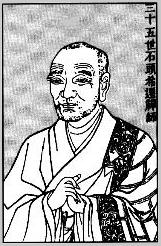
Sekito Kisen
(700-790)

Sekito Kisen
(700-790)
Ch'an (Zen) master Shih-t'ou Hsi-ch'ien (Sekito Kisen, Japanese) body is still kept at a temple in Japan to this day. The life of Shih-t'ou was very interesting and the way that he became Enlightened was another illustrative example of the method of allusion. When Shih-t'ou was twelve, he had a chance meeting with Hui-neng, the Sixth Patriarch, at the temple of Ts'ao-hsi. The Sixth Patriarch took a liking to him immediately and told him, "I will take you in as my student." Shih-t'ou was very honored and became a student of the Sixth Patriarch at the tender age of twelve.
Unfortunately, the Sixth Patriarch lived only for another three years, and Shih-t'ou was only fifteen. Before the Sixth Patriarch passed away, Shih-t'ou asked the Sixth Patriarch what he should do upon his passing. The Sixth Patriarch told him, "Go to Hsing-szu." In Chinese, the name Hsing-szu is homophonic with the words "hsun szu," which means to contemplate. Thus, it was no surprise that Shih-t'ou misunderstood the dying words of the Sixth Patriarch, and he meditated everyday, Fortunately, an elder monk figured out what was happening, and the monk told Shih-t'ou, "You are mistaken. Your teacher told you to go to your Dharma brother Hsing-szu. He is now teaching the Dharma at the hills of Ching-yuan; you should go there to pay him a visit." Now that Shih-t'ou finally understood what the Sixth Patriarch wanted him to do, he immediately left for Ching-yuan. When he arrived at Ching-yuan, the Ch'an master Hsing-szu asked him, "Where did you come from?"
"I came from Ts'ao-hsi," answered Shih-t'ou, essentially telling Hsing-szu that he came from the Sixth Patriarch.
Hsing-szu asked further, "Did you attain anything there?"
"I was not missing anything even before I got there," replied Shih-t'ou. He meant that as his Buddha-nature was complete even before he went there, there was nothing to attain.
"If you are not in need of anything, why did you go to Ts'ao-hsi?"
Shih-t'ou went on to explain, "If I had not gone to Ts'ao-hsi, how would I know that I was not in need of anything?" In other words, if he had not gone to Ts'ao-hsi, he would not have realized that he always had the Buddha-nature.
As we can see from this exchange, Ch'an masters may not point out the meaning directly. This is the method of allusion.
Shih-t'ou's body was mummified in black lacquer. Much damaged by fire, it was brought to Japan in 1911 during the time of the Chinese Revolution. It may be viewed today at the Soto Zen temple of Soji-ji in Yokohama. (For further information concerning Shih-t'ou's remains, see Bernard Faure, The Rhetoric of Immediacy: A Cultural Critique of Zen, pp. 167-168, with illustration.)
BODHIDHARMA: First Patriarch of Zen
BEFORE HUI-NENG: Five Previous Chinese Patriarchs
SRI RAMANA MAHARSHI: THE LAST AMERICAN DARSHAN
|
|
